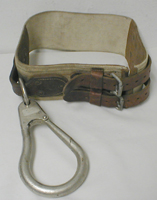Technical Details
 I bought
my pompier hook from Kathy Green in 2006, but it is far older
than that, perhaps dating from the 1960s.
I bought
my pompier hook from Kathy Green in 2006, but it is far older
than that, perhaps dating from the 1960s.
My Atlas Pompier Hook is 248 mm. tall, 137 mm. wide, 27 mm. thick, and weighs 1444 g.
The pompier hook is essentially a giant steel carabiner. Mine
is mounted on leather & canvas belt. The hook is made from
two pieces of plated drop forged steel, a steel pivot, and a spring.
The lower portion of the frame is subtriangular with a 13.4 mm
hole for attaching the hook to the belt. The upper portion is
21 mm. in diameter, as is the gate. The gate closure is a V-shaped,
with the frame concave and gate convex. The front of the frame
has raised letters reading "ATLAS S.E.CO.," "N.Y.
U.S.A.," and "DROP FORGED," with an "MB"
ligature in a small circle underneath.
Popular lore says that the pompier hook is a fireman’s tool who’s primary purpose
is to allow clipping ladder rungs. Taco Nolf (2010) tells a different story. In his words,
"I don't agree that this would be used to hook onto ladder rungs - no fireman I know would do such a sissy thing. However, I am not a fireman and certainly not a French one. The picture immediately reminded me of the fireman's belts that were in use when I was a kid in the Netherlands, in the 1950s. I saw them up close because the firemen at the station between my home and school regularly took me up their turntable ladder while they were exercising."
He then described the use of a similar Dutch belt:
"The hook on this Dutch belt is fixed and not suitable for clipping onto ladder rungs. A fireman in the 1950s wore the belt with the hook permanently attached to it, and clipped to the belt a one-handed axe in a leather holster and a cylindrical throw bag. When in difficulties with no other route of escape, the man would unholster the axe, which freed a metal spike in a small pocket behind the blade. The spike was about 7inches long by 3/8inch thick and square in section, with a point at one end and an eye at the other. Using the flat of the axe, the spike was hammered into the nearest solid piece of wood. The eye then formed the attachment point for the top end of the escape rope which was coiled in the throw bag. From memory, the rope was about 20 meters long and about 1/2inch in diameter, with a carabiner spliced into the top end. The rope was coiled so as to feed from the top of the bag, with the carabiner laid on top. The bag was pulled open, the carabiner clipped to the spike, and the bag thrown out of the window with the remainder of the rope. Two turns of the rope around the belt hook for friction, grab the rope below the belt hook and away you go. I have seen them do it with another man over their shoulders in a Fireman's Lift but I would expect that in that case they would take three or four turns of the rope through the belt hook. Remember, in those days there were no female firefighters, and these guys all looked the part."
I agree with Taco: only a wimp fireman would use a pompier hook as a ladder hook, but that's the "lore" around them and current versions of giant carabiners called "pompier hooks" are still widely sold as ladder positioning devices.
Cavers once used pompier hooks for rappelling
(way back in the manila rope days), rigging it like a carabiner
wrap. The famous John Cole described it as follows:
"Fireman's Pompier Hook - This device can be used with limp or stiff nylon or manila rope of any diameter suitable for climbing and it will pass knots. It allows for incremental friction adjustment to increase controllability by adding or taking off turns, but to do this, the rope beneath must be lifted over the caver's head. The device will kink the rope and will spin a caver who is not touching the wall. Being made of steel, it does not tend to wear quickly, but does not conduct heat readily either. It is safe, somewhat large, somewhat heavy, costs about $25 and can sometimes be obtained through a fire department."
--- John Cole, 1967. "Rappel Devices." The Huntsville Grotto News, Vol. 8, No.2, pp. 47-52. Reprinted in the 1967 Speleo Digest.

For far more content, use a larger monitor and a full-width window.
Hundreds of cell phone users complained and asked me to for a simpler, mobile friendly site. In particular, they wanted me to limit each page to a small number of pictures and minimize my use of text. This new site provides what they asked for.

